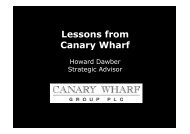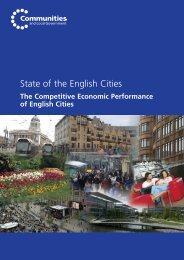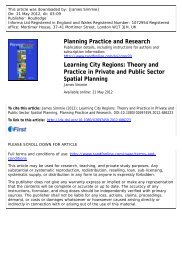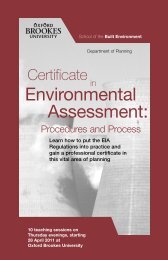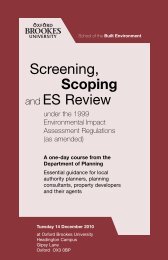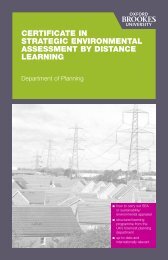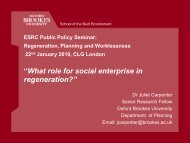History Matters: Path dependence and innovation in British city ...
History Matters: Path dependence and innovation in British city ...
History Matters: Path dependence and innovation in British city ...
Create successful ePaper yourself
Turn your PDF publications into a flip-book with our unique Google optimized e-Paper software.
Figure 24: Cambridge <strong>and</strong> Swansea employees <strong>in</strong> R&D <strong>and</strong> higher education comb<strong>in</strong>ed<br />
1981-2006<br />
30,000<br />
25,000<br />
Number<br />
of<br />
employees<br />
20,000<br />
15,000<br />
10,000<br />
5,000<br />
0<br />
1981<br />
1984<br />
1987<br />
1989<br />
1991 (CE)<br />
1991 (AES)<br />
1993<br />
1995<br />
1996<br />
1997<br />
1998 (AES)<br />
1999<br />
2000<br />
2001<br />
2002<br />
2003<br />
2004<br />
2005<br />
2006<br />
Years<br />
Cambridge<br />
Swansea<br />
Knowledge identification<br />
Accord<strong>in</strong>g to ‘absorptive capa<strong>city</strong>’ theory,<br />
the sectoral <strong>and</strong> occupational structure <strong>in</strong> a<br />
<strong>city</strong> economy shapes the ability of its firms to<br />
identify new knowledge. Data from CIS4 (see<br />
Figure 23) suggest that Cambridge firms utilise<br />
external <strong>in</strong>formation much more extensively<br />
than their counterparts <strong>in</strong> Swansea, <strong>and</strong> <strong>in</strong>deed<br />
more than the national average; this implies<br />
that Swansea firms rely more on <strong>in</strong>ternal than<br />
external <strong>in</strong>formation as a factor <strong>in</strong> <strong><strong>in</strong>novation</strong>.<br />
Furthermore, Swansea firms seem to make less<br />
than average use of most <strong>in</strong>formation sources<br />
aside from universities, government <strong>and</strong> public<br />
research bodies.<br />
This difference is compounded by major<br />
variations <strong>in</strong> the absolute numbers employed<br />
<strong>in</strong> key knowledge-based activities, such as<br />
R&D <strong>and</strong> higher education (see Figure 24).<br />
Cambridge has tripled the number of such<br />
workers s<strong>in</strong>ce the early 1980s, <strong>in</strong> l<strong>in</strong>e with<br />
the growth of the high-tech economy; their<br />
number is currently estimated by CIS4 at<br />
around 25,000. As the cluster has grown, so<br />
has the pool of knowledge workers, which then<br />
re<strong>in</strong>forces the <strong>in</strong>novative performance of the<br />
economy. The <strong>city</strong> has thus developed a vital<br />
critical mass of such workers:<br />
“There is no doubt that it is the size of the<br />
technical, scientific <strong>and</strong> highly educated<br />
workforce that is a key <strong>in</strong>gredient of<br />
Cambridge’s success. Some of these workers<br />
have been drawn from the university, but<br />
many also come from elsewhere <strong>in</strong> the UK,<br />
even globally, to work <strong>in</strong> Cambridge. The<br />
cluster is able to attract the knowledge<strong>in</strong>tensive<br />
workers it needs, <strong>and</strong> there is<br />
a significant movement of these workers<br />
between firms with<strong>in</strong> Cambridge. In this<br />
sense there is a constant circulation of<br />
knowledge with<strong>in</strong> the cluster. And such<br />
people, by their very nature, are also<br />
used to search<strong>in</strong>g for <strong>and</strong> acquir<strong>in</strong>g<br />
relevant <strong>in</strong>formation <strong>and</strong> knowledge from<br />
elsewhere.” [Interview CAMB001]<br />
Interviews with Cambridge firms suggest<br />
that they use multiple sources of relevant<br />
<strong>in</strong>formation <strong>and</strong> knowledge for <strong><strong>in</strong>novation</strong>. As<br />
one firm puts it:<br />
“We generate the knowledge needed<br />
for <strong><strong>in</strong>novation</strong> <strong>in</strong> several different but<br />
<strong>in</strong>teract<strong>in</strong>g ways. We have our own<br />
dedicated research groups of highly<br />
qualified scientists <strong>and</strong> eng<strong>in</strong>eers. We<br />
appo<strong>in</strong>t people who are th<strong>in</strong>kers, who can<br />
see where technological improvements can<br />
be made, <strong>and</strong> are problem solvers. They are<br />
concerned with develop<strong>in</strong>g <strong>and</strong> extend<strong>in</strong>g<br />
our technologies. They are allowed a<br />
certa<strong>in</strong> amount of time – say around 10 per<br />
cent – to ‘th<strong>in</strong>k outside the box’. Ma<strong>in</strong>ly,<br />
however, they are work<strong>in</strong>g on technological<br />
developments, improvements <strong>and</strong> advances<br />
<strong>in</strong> response to new market opportunities,<br />
46




